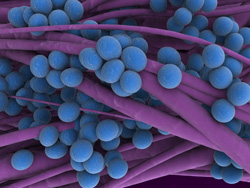Stripping Staphylococcus of its protective coat
S. aureus can form structures, biofilms, that help the bacterium to resist antimicrobial therapy. The formation of an adherent and multilayer film of densely packed microbial cells that surround themselves with secreted polymers is formidable protection against any action designed to control them either inside or outside the body in hospital wards. The structure of the biofilm is primarily composed of exopolysaccharides which have attracted most research efforts. The EU-funded 'Characterization of protein-dependent biofilms by Staphylococcus aureus' (Protein-Biofilm) project turned their attention to a matrix in S. aureus that is dependent on proteins for its development. The project team identified and characterised three proteins in the bacterium's biofilm – protein A, fibronecting binding protein and biofilm-associated protein (Bap). Using appropriate techniques including two-dimensional (2D) nanoliquid chromatography and mass spectrometry, adhesion and invasion assays, the scientists investigated the characteristics of each protein that promote the successful formation of the protective layer. Protein A is a major component of the biofilm matrix and promotes bacterial aggregation and biofilm formation. This particular protein plays the promotion role in continuous flow and static culture conditions independently of the important exopolysaccharide PIA-PNAG. Interestingly for control, immunoglobulin A or anti-protein A antibodies prevented full capacity for biofilm production. Mediating biofilm production, the family of 20 LPXTG proteins are all important constituents of the biofilm matrix. One of the group, fibronecting binding protein, was shown to play a particularly important role in matrix production. The Bap is able to induce a protein-dependent biofilm matrix in some strains of S. aureus and promoted bacterial cell adhesion to two epithelial cell lines. Another protein Gp96 is associated with the inhibition of Bap-mediated invasion at the cell surface. S. aureus is one of the five most common causes of hospital infections and is often the cause of post-op wound infections. Methicillin-resistant S. aureus is most feared as it is resistant to just about all antibiotics. Identification of novel targets for the prevention of biofilm development stands to be very useful in the battle against staphylococcal proteinaceous-building biofilm infections.







